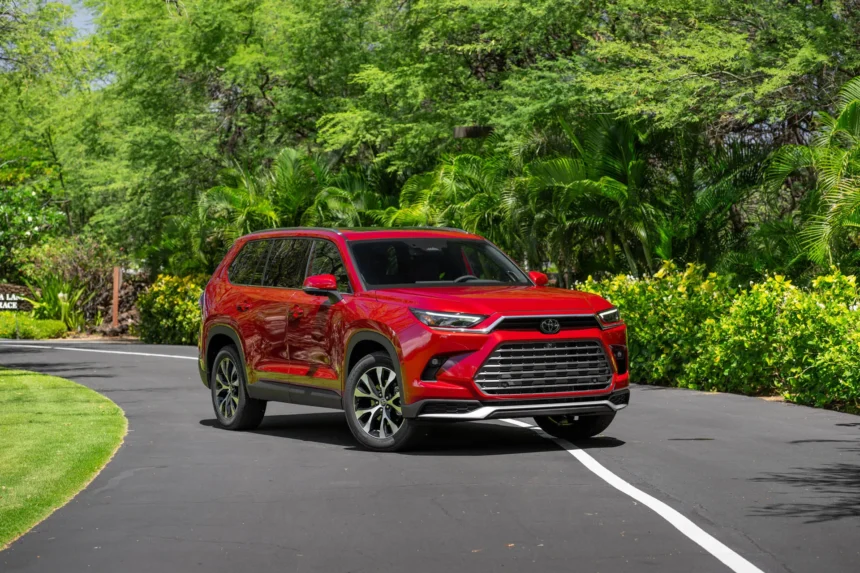Toyota has expanded its lineup of three-row SUVs with the introduction of the Grand Highlander in 2024. This new model is larger, wider, taller, and offers a roomier third row compared to the standard Highlander. The Grand Highlander is designed to cater to families who may prefer an SUV over a minivan like the Sienna.
One of the key differences between the Highlander and the Grand Highlander is their size. The Grand Highlander measures 201.4 inches long, 2.3 inches wider, and 2.0 inches taller than the Highlander. It also has a longer wheelbase, providing more passenger and cargo space. The Grand Highlander has a ground clearance of 8.0 inches, similar to the Highlander, making it easy to get in and out of the vehicle.
In terms of passenger and cargo space, the Grand Highlander offers more room than the Highlander. It has a passenger volume of 153.3 cubic feet compared to 141.3 cubic feet in the standard Highlander. The Grand Highlander also has 20.6 cubic feet of space behind the third row, while the Highlander only offers 16.0 cubic feet. Additionally, the Grand Highlander comes standard with captain’s chairs and a seven-passenger configuration, providing more flexibility for seating arrangements.
The third row of the Grand Highlander is particularly spacious, with 33.5 inches of rear legroom compared to 27.7 inches in the standard Highlander. The raised floor in the third row may make toe room tight, but it can be easily adjusted by sliding the second-row seats forward. The Grand Highlander also features dual cup holders and USB ports in the rear for added convenience.
In terms of design, the Grand Highlander has a more sophisticated and cohesive look compared to the Highlander. Its smooth body sides, boxy fenders, and calmer front fascia give it a more upscale appearance. The Highlander, on the other hand, features a snarling face and design elements borrowed from the Sienna minivan.
Overall, the Grand Highlander emerges as the best Highlander yet, offering more space, functionality, and a stylish design. With its expanded lineup and powerful Hybrid Max powertrain option, the Grand Highlander is a compelling choice for families in need of a versatile and spacious SUV. The Toyota Highlander has always been a popular choice in the three-row crossover SUV segment, offering a blend of comfort, space, and reliability. However, the new Grand Highlander takes things up a notch with a more upscale and aggressive design.
The Grand Highlander eschews the bulges typically seen in trucky SUVs like the Toyota Sequoia, instead leaning into the Lexus side of things. The front end is dominated by a large lower grille that tapers up like the Lexus spindle grille, giving it a more premium look. Flanked by fog lights and LED headlights, the Grand Highlander makes a bold statement on the road. Daytime running lights add a touch of sophistication to the overall design.
Moving towards the rear, the Grand Highlander maintains a smooth and sleek profile, with a beltline that curves up into the rear quarter windows, providing plenty of outward visibility for rear-seat passengers. Integrated rear roof spoilers add a sporty touch, while the Hybrid Max models boast dual exhaust tips and black 20-inch wheels for a more aggressive appearance.
When it comes to interior design, the Grand Highlander continues to impress. Smart storage spaces, such as a passenger shelf for smartphones above the glove box, ensure that everything has its place. Bronze accents on the dash and console add a touch of elegance, while the open bridge console in the Grand Highlander provides additional storage space. The available 12.3-inch touchscreen is seamlessly integrated into the dash and console, giving the interior a more cohesive and modern look.
In terms of performance, the Grand Highlander offers a range of powertrain options to suit different needs. The base 2.4-liter turbo-4 engine delivers 265 hp and 310 lb-ft of torque, providing plenty of grunt for passing maneuvers. The optional 2.5-liter inline-4 hybrid system, shared with the standard Highlander, offers a good balance of efficiency and power. However, the Grand Highlander’s exclusive Hybrid Max powertrain, with a turbo-4 hybrid system producing 362 hp and 400 lb-ft of torque, takes performance to the next level.
When it comes to fuel economy, the Grand Highlander remains competitive. The hybrid models offer impressive efficiency ratings, with the Grand Highlander Hybrid Max achieving a combined rating of 27 mpg. The standard turbo-4 engine is also relatively efficient, especially for its size.
Overall, the Grand Highlander stands out in the crowded three-row SUV segment with its bold design, upscale interior, and impressive performance options. Whether you prioritize style, comfort, or efficiency, the Grand Highlander has something to offer for every driver. We conducted testing on the new Toyota Grand Highlander, hoping to see it exceed expectations and rival the performance of its turbo-6 counterpart. Unfortunately, our results fell short of this goal, and the Grand Highlander ended up with a rating more in line with the turbo-4.
Despite this setback, there are still advantages to the smaller Highlander model. The Grand Highlander may have missed the mark in terms of performance, but it does offer some appealing features that set it apart from its predecessor.
In terms of pricing and trims, the base Highlander LE starts at $41,000, while the base Grand Highlander LE is slightly higher at $42,310. Both models offer a hybrid option with a $1,600 upcharge. For the best value, the Highlander XLE and Grand Highlander XLE are recommended picks.
When it comes to choosing between the two models, the Grand Highlander comes in LE, XLE, Limited, and Platinum trims, positioning itself as a more premium option. The base LE includes features such as a 12.3-inch touchscreen, wireless smartphone integration, synthetic leather upholstery, heated power seats, and a power tailgate.
The Grand Highlander Hybrid LE starts at around $46,000, with the Hybrid Platinum reaching up to $53,000. The Hybrid Max, which comes with standard AWD, starts at $55,785 in Limited trim and goes up to nearly $60,000 in Platinum models.
On the other hand, the Highlander offers LE, XLE, XSE, Limited, and Platinum trims, with prices ranging from $41,000 to $54,000. The base model includes an 8.0-inch touchscreen, power driver seat, cloth upholstery, and 18-inch wheels. The Highlander Hybrid options have been streamlined, starting at $47,450 for the XLE Hybrid AWD.
Overall, the 2025 Toyota Highlander earns a respectable TCC Rating of 7.0 out of 10, thanks in part to the introduction of the Grand Highlander. While the Grand Highlander may not have lived up to our expectations in terms of performance, it offers a roomier, better-equipped, and more attractive alternative to the Highlander, all for just a slightly higher price. Ultimately, the choice between the two models will come down to individual preferences and priorities. the perspective of a young entrepreneur who just launched their first startup:
As a young entrepreneur, launching my first startup has been both exhilarating and nerve-wracking. After months of planning, researching, and developing my product, I finally took the plunge and introduced it to the world. The feeling of seeing something that I created come to life and potentially make a difference in people’s lives is truly indescribable.
The journey to launching my startup was not without its challenges. From securing funding to building a strong team to navigating the complexities of the market, there were many obstacles to overcome. However, each hurdle only served to strengthen my resolve and determination to succeed.
One of the most rewarding aspects of starting my own business has been the opportunity to bring my vision to fruition. I have always been passionate about solving a particular problem, and being able to create a solution that addresses that issue has been incredibly fulfilling. Seeing the positive feedback and excitement from early users has been validation that my hard work has been worth it.
Of course, the road ahead is still filled with uncertainty and challenges. As a new entrepreneur, I am constantly learning and adapting to the ever-changing landscape of the business world. I am aware that there will be setbacks and failures along the way, but I am committed to pushing through and continuing to grow and evolve as a founder.
One of the most important lessons I have learned so far is the value of perseverance and resilience. Building a successful startup requires dedication, hard work, and a willingness to learn from mistakes. It is not always easy, but the satisfaction of seeing my business grow and succeed makes it all worthwhile.
As I look towards the future, I am filled with excitement and optimism for what lies ahead. I am confident in the potential of my startup and am eager to see how it will continue to evolve and make a positive impact on the world. Launching my first startup has been a challenging yet rewarding experience, and I am grateful for the opportunity to pursue my passion and make a difference through entrepreneurship.






